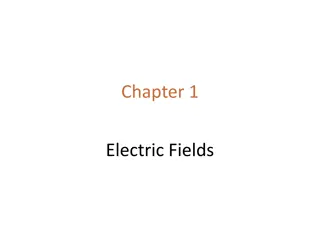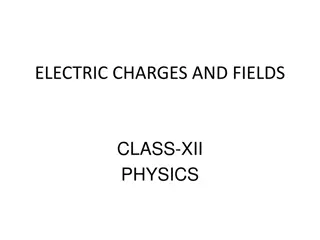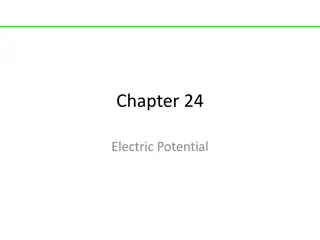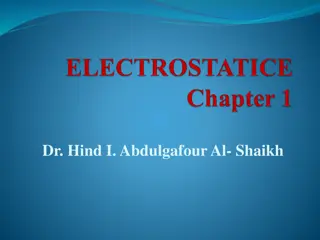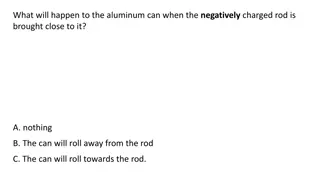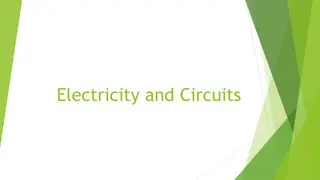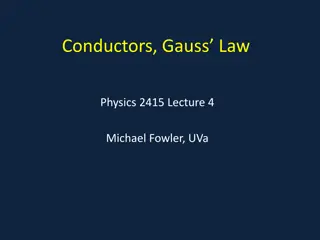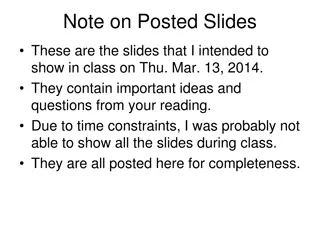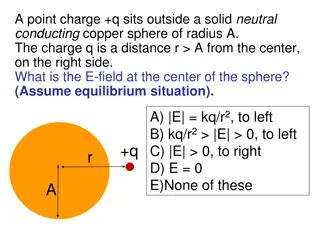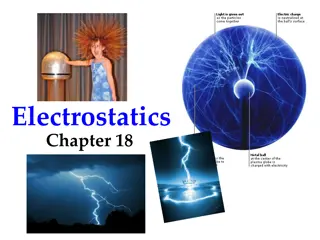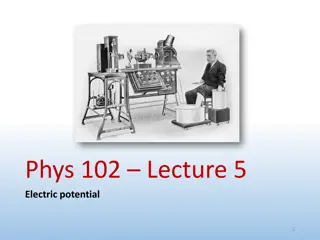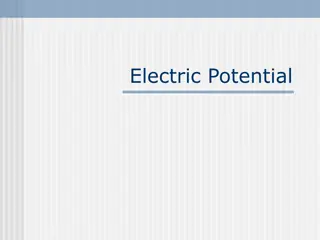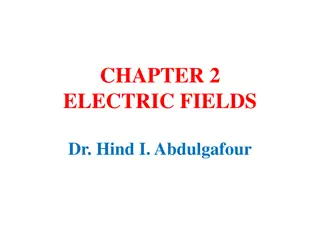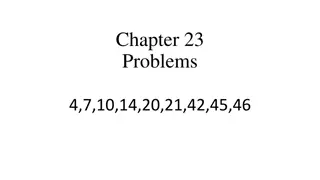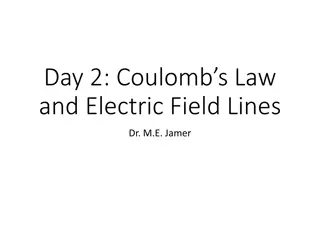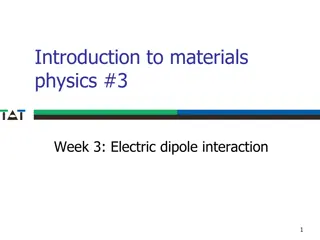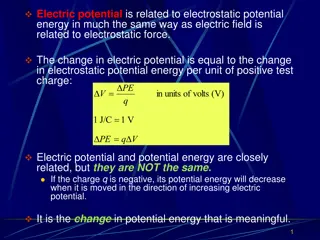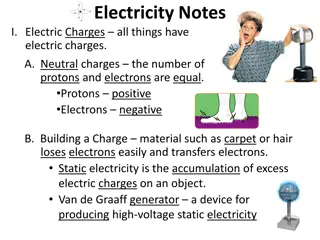Understanding Electric Field Lines and Charges
Electric field lines provide a visual representation of the electric field around charges. They show the direction of the electric field and help understand the intensity of the field at different points. Field lines never cross each other and the tangent at any point on a line gives the field direction. Learning about electric field lines is essential in grasping the concepts of electric fields and charges.
Download Presentation

Please find below an Image/Link to download the presentation.
The content on the website is provided AS IS for your information and personal use only. It may not be sold, licensed, or shared on other websites without obtaining consent from the author. Download presentation by click this link. If you encounter any issues during the download, it is possible that the publisher has removed the file from their server.
E N D
Presentation Transcript
Chapter 22 Electric Field
The area around a charge is called electric filed Test charge: +1C charge Force acting on test charge is electric field (E) 1 . r q q = = E k k 2 2 r +1C +1C +1C + +1C +1C +1C +1C The direction in which +1C charge moves is the direction of electric field which is represented by an arrow and is called electric field line +1C Electric lines of force moves away from the +ve charge
+q0 Test charge is +q0 Electric field can also be written as +q0 F +q0 E = 0 q The unit of electric field is N/C - +q0 +q0 Electric lines of force moves towards the -ve charge = +q0 +q0 F q E 0 +q0
1. An electric field line is an imaginary line or curve drawn through a region of empty space so that its tangent at any point is in the direction of the electric field vector at that point. weak field 2. The relative closeness of the lines at some place gives an idea about the intensity of electric field at that point. Strong field 3. Electric field lines are imaginary lines and they never crosses each other. If they crosses a single point will have two directions of a electric field which is not possible.
Tangent at each point in the line of force gives the direction of electric field at that point + + +1C +1C +1C +1C
+ - +1C
T111-Q5. Four particles, with the same magnitude of charge, are placed at the corners of a square, as shown in Figure 3. Which configuration gives an electric field, at the center of the square, pointing to the right? A) 3
Q4. What is NOT TRUE about electric field lines: A) They are extended away from a negative point charge. B) They are the path followed by a unit positive charge. C) Two electric field lines never cross each other. D) They are imaginary lines used to visualize the patterns in the electric field. E) The direction of the electric field at a point in the field line is given by the tangent at that point. Ans. A and B.
T51-Q#4. Six point charges are placed on the corners of a regular hexagon as shown in the figure 2. Five of them have a charge of +1.0 C and the sixth has a charge of 1.0 C. If the distance from the center of the hexagon to its corner is 1 cm, what is the electric field at the center? (Ans: 1.8 x 108 N/C.) T041:Q#1: The electric field produced by a +3.0 C charge at a point 1000 m to the left of the charge is (Ans: 2.7x104 N/C toward the left) T92-Q6. Figure 1 shows a particle with positive charge Q and a particle with negative charge Q both fixed in place. What is the electric field at point P? [Take Q = 1.00 C] A) + 432 j (N/C)
T103-Q6. A 40 C charge is positioned on the x-axis at x = +4.0 cm. Where on this axis should a 60 C charge be placed in order to produce a zero net electric field at the origin? A) +4.9 cm T32-Q#4: At which point can the electric field due to the two charges shown in figure 6 be zero? (Ans: point E.) T83-Q2. A point charge Q = - 500 nC and two unknown point charges , q1 and q2 , are placed as shown in Fig. 2. The net electric field at the origin O , due to charges Q, q1 and q2, is equal to zero. The charges q1 and q2, respectively, are: A) + 131 nC, 106 nC
T103-Q6. A 40 C charge is positioned on the x-axis at x = +4.0 cm. Where on this axis should a 60 C charge be placed in order to produce a zero net electric field at the origin? A) +4.9 cm T32-Q#4: At which point can the electric field due to the two charges shown in figure 6 be zero? (Ans: point E.)
T102-Q2. Two charges, +2.00 nC and 2.00 nC, are positioned at the coordinates (1.00 m , 0) and (0, 1.00 m) respectively in an isolated space. The magnitude and direction of the electric field at the origin are: A) 25.5 N/C, 1350 from positive x-axis T91-Q2. Three point charges are fixed on the y axis, as shown in Figure 1, with q = +1.0 C. The net electric field at point P is zero. What is the charge Q ? A) 0.43 C T101-Q2. Two particles are held fixed on an x-axis. Particle 1 of charge q1 = 2.1 10 8 C is at x = 20 cm and particle 2 of charge q2 = 4.00q1 is at x = 70 cm. At what coordinate on the x-axis is the net electric field produced by the particles equal to zero? A) 30 cm
T91-Q2. Three point charges are fixed on the y axis, as shown in Figure 1, with q = +1.0 C. The net electric field at point P is zero. What is the charge Q ? A) 0.43 C
T081Q3.Two identical charges each of charge Q are positioned at points A ( 5.0 m, 0.0 m) and B( -5.0 m, 0.0 m) to produce a net electric field of -10j N/Cat point C ( 0.0 m, 5.0 m). Find the value of Q.( Ans: -39 nC) T72-Q1. Two charges are arranged as shown in the figure 1. If d=7.2 cm, what is the resultant electric field at P? (Ans: 1.23 x 104 N/C making an angle of 45o with + x-axis) T062Q2.Three point charges q1, q2, and q3 are fixed at the three corners of a right-angle triangle as shown in figure (1). Given that q1 = q2 = +3.2 10-19 C while q3 = -1.6 10-19 C, and b = 5.0 cm. The magnitude of the net electric field at point P due to all the three point charges is: (Ans: 1.15 x 10-6 N/C)
Uniform Electric Field The electric field strength (E) between two very long parallel plates will be uniform - - - - - - - - - - - - - - - - - - - - - - - - - - - - - - - - - - - - - - - - - - - - - - - - - - - - - - - +++++ +++++ +++++ +++++ +++++ +++++ +++++ +++++ +++++ +++++ +++++
The repulsive force acting on the charge q is E + - + F = ma = + + + + + qE qE qE - - - - - - + + + + + + - + + + - - - - - + + + + + - - - q - - - - - a = + m , - , , , v v a d t 0 Out of these 5 you need 3 known rest 3 find from either of the following equations = + ( ) v v at i 0 = + 2 ( ) d v t at ii 1 If Charge is q, the force will be attractive 0 2 = + 2 2 0 2 ( ) v v ad iii
Particle hanging or moving with constant velocity - - - - - - - mg = - - - - - - - - - - qE - - - - - qE q , , , , v v a d t 0 mg Out of these 5 you need 3 known rest 3 find from either of the following equations + + + + + + + + + + + + + + + + + + + + + + = + ( ) v v at i 0 = + 2 ( ) d v t at ii 1 0 2 = + 2 2 0 2 ( ) v v ad iii
T111-Q3. A proton of initial velocity 2.0 103 m/s enters a uniform electric field of strength 3.0 N/C. The initial velocity of the proton and the electric field are in the same direction. The distance travelled by the proton in a time t = 2.0 s is: (Ignore the gravitational force) A) 4.6 mm T62-Q4.The electric field between two long and parallel charged plates is uniform, and is equal to E= (240 N/C)j. An electron with velocity components vx = 3.0x105 m/s and vy = 2.0x10 3 m/s enters the region between these plates. The acceleration of the electron when its x-coordinate has changed by 2 cm is: (Ans: - 4.2 x 1013j m/s)
Q#4. A proton with a speed of 3.0105 m/s moves in uniform electric field of 1.9 103 N/C. The field is acting to decelerate the proton. How far does the proton travel before it is brought to rest? (Ans: 0.25 m ) 91-Q3. An electron is initially moving with velocity v = + 5.0 106i (m / s ) . What electric field is needed to momentarily stop the electron in a distance of 3.0 cm? A) + 2.4 kN/C i A charged particle with a mass of 2x10-4 kg is held suspended T052: Q#4. (stationary) by a downward electric field of 300 N/C. The charge on the particle is: (Ans: 6.5 x 10-6 C )
Q#4. A proton with a speed of 3.0105 m/s moves in uniform electric field of 1.9 103 N/C. The field is acting to decelerate the proton. How far does the proton travel before it is brought to rest? (Ans: 0.25 m )
T42-Q#5 A uniform electric field is set up between two large charged plates, see Figure 3. An electron is released from the negatively charged plate, and at the same time, a proton is released from the positively charged plate. They cross each other at a distance of 5.00x10-6 m from the positively charged plate. If only the field due to the charged plates is considered, find the distance between the two plates. [Take the ratio mass of the electron : mass of the proton = 1 : 1833] [A1 9.19 mm.] + - Plate p e - Plate + Plate Figure 3
T62-Q3.Figure (2) shows a chargedball of mass m = 1.0 gis suspended by a light string in the presence of a uniform electric field, E= ( -3.0 x 10 5 N/C ) i.In this field, the ball is in equilibrium at = 37 0. The charge "q" on the ball is: (Ans: -2.46 x10-8 C) y
T103-Q4. A small charged sphere of mass 0.40 g is suspended by a light string (L = 24 cm) in a uniform electric field directed along the positive x direction as shown in Figure 3. The sphere has a charge of q = 90 nC. The charge is in equilibrium at an angle = 33 . Find the magnitude of the electric field to achieve equilibrium. A) 28 kN/C T103-Q5. A proton is moving to the right with a constant velocity of 4.5 105 m/s. Find its velocity 3.0 s after entering a uniform electric field of 1100 N/C directed to the left. Ignore gravity. A) 1.3 105 m/s to the right
Q11. What is the change in density of an aluminum cube of mass 200 g and of edge length 5.0 cm when heated from 10 oC to 80oC (coefficient of linear expansion of aluminum 23 10 6 /oC). A) 7.7 10 3 g/cm3
T91-Q3. An electron is initially moving with velocity v = +5.0 106 (m/s). What electric field is needed to momentarily stop the electron in a distance of 3.0 cm? A) + 2.4i kN/C T101-Q4. A charged oil drop with a mass of 2 10 4 kg is held suspended in equilibrium in the air by a downward electric field of 300 N/C. The charge on the drop is: A) 6.5 10 6 C T92-Q8. A proton with a speed of 4.0 106 m/s moves in uniform electric field of 3.8 103 N/C. The field is acting to decelerate the proton. How far does the proton travel before it is brought momentarily to rest? A) 22 m
d E- E+ +1C E P -q +q x Electric dipole moment (p) p = qd The direction of dipole moment is taken from ve to +ve charge T92-Q7. An electric dipole consists of a particle with a charge of +6.0 10 6 C at the origin and a particle with a charge of 6.0 10 6 C on the x axis at x = 3.0 10 3 m. Its dipole moment is: Net electric field (E) due to dipole at distance x 2 x p E = k A) 1.8 10 8 C.m, in the negative x direction 3 1 = = 9 2 2 . 8 99 10 / k Nm C 4 0
+2e H H + + = 2 H O H O 2 O -2e H2O molecules H +e + + = H Cl HCl Cl -e Hydrochloric acid
Torque on dipole E + = d F - + + + + + + - - - - - - + + + + + + - + + + - - - - - = = d qd qE + + + + + - - - - - - - - d sin( ) ( ) E + - = p E F = sin pE Axis of rotation d 2 d 2 is the angle between p and E F = + F F = d F
Work done by electric field E + = F . W d - + + + + + + - - - - - - + + + + + + - = = qE . E p . ( U W W d + + + - - - - - + + + + + - - - - - - - - ) + = = = 0= cos E . W U U p - U U pE 0 Lets consider when ( ) = 900 then U0 = 0 then F = cos U pE Axis of rotation is the angle between p and E F d 2 d 2 = + F . F . W = E . U p = F . W d
Work done by electric field = W U Work Done by external agent Wa = W Potential Energy of Dipole . = U p E Torque on the Dipole = p E
T103-Q7. The dipole moment of a dipole in a 200 N/C electric field is initially perpendicular to the field, but it rotates so it is in the same direction as the field. Find the work done by the field if the dipole moment has a magnitude of 2 10 8 C m. A) 4 J T83-Q4: An electric dipole of dipole moment p = (5 10-10 C.m) i is placed in an electric field E =(2 106 N/C) i + (2 106 N/C) j. What is magnitude of the maximum torque experienced by the dipole? A) 1.00 10-3 N.m T102-Q3: electric dipole moment of magnitude p = 3.02 x 10-25 C.m makes an angle 64o with a uniform electric field of magnitude E = 46.0 N/C. The work required to turn the electric dipole by 90o is: A) 1.86 x 10-23J
T91-Q4. An electric dipole consists of two opposite charges, each of magnitude 2.0 nC. A uniform electric field of magnitude 300 N/C makes an angle of 25 with the dipole moment of the dipole. If the torque exerted by the field has a magnitude of 2.5 10-11 N.m, the distance between the two charges of the dipole is: A) 99 m
T111-Q4. An electric dipole consists of two particles, each having a charge of magnitude 2.0 nC. It is placed in an external electric field of magnitude 500 N/C. The electric potential energy of the dipole is 2.0 nJ when it makes an angle of 60o with the field. What is the separation between the two charges of the dipole? A) 4.0 mm
T071 Q17. Two charges Q1 and Q2 of equal magnitudes and opposite signs are positioned as shown in the figure 1. Which of the shown arrows represents correctly the electric field at point P. (Ans: A) T81-Q4.The dipole moment of a dipole in a 300-N/C electric field is initially perpendicular to the field, but it rotates so that it becomes in the same direction as the field. If the electric dipole moment has a magnitude of 2.0 x 10-9 C.m, the work done by the field is: (Ans: +6.0 x10-7 J T91-Q4: An electric dipole consists of two opposite charges, each of magnitude 2.0 nC. A uniformelectric field of magnitude 300 N/C makes an angle of 25 with the dipole moment of thedipole. If the torque exerted by the field has a magnitude of 2.5 10-11 N.m, the distance between the two charges of the dipole is: Ans: 99 m
T81-Q4.The dipole moment of a dipole in a 300-N/C electric field is initially perpendicular to the field, but it rotates so that it becomes in the same direction as the field. If the electric dipole moment has a magnitude of 2.0 x 10-9 C.m, the work done by the field is: (Ans: +6.0 x10-7 J
T101-Q3. An electric dipole consists of charges 6.0 10 6 C and +6.0 10 6C separated by a distance of 3.0 mm. Its dipole moment is directed along the +x- axis. This dipole is placed in an electric field of magnitude 46 N/C that makes an angle of 60o with the +x-axis. What is the magnitude of the torque exerted by the electric field on the dipole? A) 7.2 10 7 N.m.
+ + + + + + + + + + L q = Liner charge density ( ) L + + + + + + + + + + + + + + + + + + + + + + + + + + + + + q = Surface charge density ( ) A A + + + + + + + + + + + + + + + + + + V q = Volume charge density ( ) V + + + + + + + + + +
P = 2 . q R z q = E k + 3) / 2 ( z R + + + + + + + 1 = = 9 2 2 . 8 99 10 / k Nm C + 4 + 0 + R + + + + + + +



